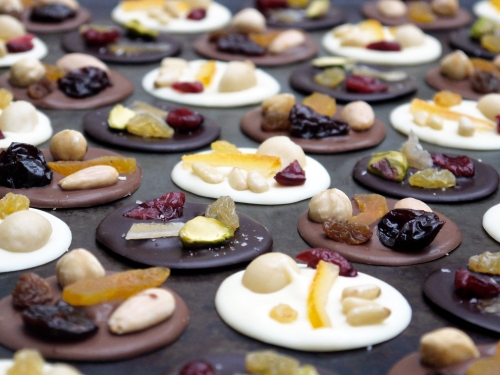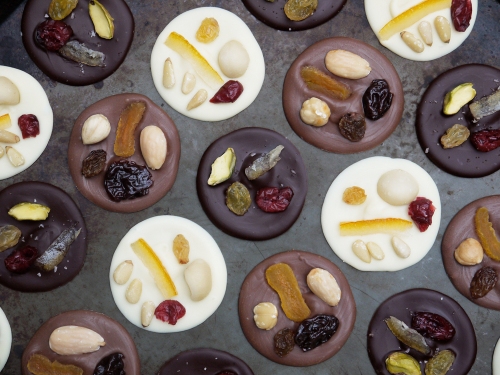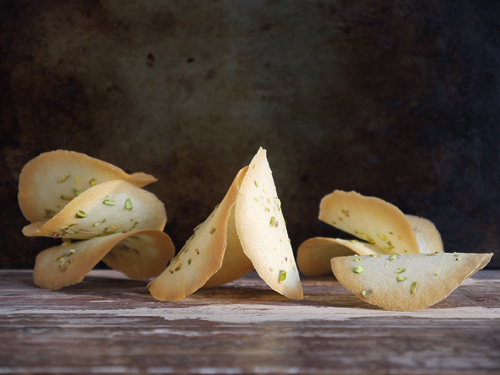Do you like the idea of a grand total of thirteen desserts for your Christmas dinner? Then let’s take a jaunt to Provence in France where they do just that.
But first I will have to disappoint you. If you have visions of a seasonal table just groaning with thirteen separate cakes, it is not that. Not is it a selection of other puddings. Rather it is a selection of festive treats ranging from nuts and dried fruit to festive breads and small traditional sweets, including nougat. But hey, you still get thirteen things in total, and after lots of rich food, some vaguely heathy nuts and dried fruit might be just the little health kick you need as you promise not to over-indulge ever again. And, of course, you know it will happen again next year!
One of the traditional sweets is the calisson. They originate from the town of Aix-en-Provence and are made with several typical products of the area – candied melon, orange peel, orange blossom water and almonds. Everything is ground down to a smooth paste – with a texture similar to marzipan but somewhat fruitier – which is then shaped into almond-like lozenges and glazed with brilliant white royal icing. If you wanted to veganise these, you could even make your icing using aquafaba (update: I tried this and it works. I’ve added a note to the recipe below).

And as with all good Christmas sweets, they have both a bit of history and a disputed origin story.
One school of thought is that they trace their history back to medieval Italy, being mentioned in Martino di Canale’s Chronicle of the Venetians in 1275, and there are other references during the Middle Ages to “calisone” cakes being made from almonds.
The other version involved a bit more drama, and is therefore immediately more interesting. The tale goes that calissons were created after the marriage of René, Duke of Anjou and Count of Provence, to Jeanne de Laval in 1454. He was 45, she was 21. Before and after the marriage, the bride was reported to be in a dour mood, what with being basically told to enter into a marriage by her father. After three years of marriage the couple moved to Aix-en-Provence and the duke’s chef was charged with creating something to bring a smile to her lips so that the couple would impress their subjects. He created these sweets from melon and almonds, and upon tasting this new delicacy, she declared “di calin soun” which is “they are hugs” in the Provencal language. Alternatively, the assembled crowd said that the sight of the smiling Jeanne won their hearts and felt as if she was giving them all little hugs. Could one of these be true? It’s certainly a charming tale, and we can only hope the rest of their union was happy.
I’ve had an eye on making calissons for a while, but was always a bit dubious how much work it would take to make. The do look like it will be a lot of effort. Well it turns out that it actually…really easy. You let your food processor do all the hard work, which will blitz everything to a paste. Throw in the candied fruit, blitz to a smooth paste, then add the almonds and it all comes together like magic.

While making the fruit-nut base was easy, I’ll admit the shaping was a bit tricky. You roll out the dough, then place rice paper on top and cut out shapes. I thought this would leave you with a lot of waste, but you can pick off the rice paper and re-roll the scraps. No, the problem is they are supposed to have an almond shape, and I didn’t have that exact cutter. Time for a workaround…
My very practical solution was to use a circular cutter (mine was about 5cm diameter), then offset it to create that almond shape. Place the rice paper on the dough, then press down hard and fast. That means you get a clean cut through the rice paper, and the dough doesn’t get a chance to move position. It’s also marvellously therapeutic after the year we’ve had. Then remove the cut circle, flip it over so the rice paper is on the bottom (if you have the rice paper on the top for the second cut, it doesn’t work as well). Offset the cutter so you can cut an almond shape (this way you will get two from each circle). I found it best to press down, then flip over the cutter and gently run a knife over the rice paper to cut if cleanly. It is a little tricky to start with, but you get the hang of it. It is also important to have a clean cutter – keep a damp piece of kitchen roll nearby, and wipe it often.
The classic fruit in calissons is candied melon. This is something I’ve rarely seen, and it strikes me as something that must be tricky to make given how much water is in a melon. But I managed to order some candied cantaloup melon online, and even then it’s not exactly easy to find. It’s definitely an interesting flavour, aromatic, and it has an attractive orange-pink colour. Many recipes also use a little bit of candied citrus peel, and if you wanted to go for orange overload, you could just use that. Alternatively, any candied fruit will work well, In fact, I’ve made a little selection of different flavours for over Christmas, and the same recipe works as long as you hold to the same weight of candied fruit, candied citrus peel, ground almonds and icing sugar.
I got the idea to experiment because I came across a few websites that have given calissons the full macaron treatment, presenting them in a dazzling rainbow of colours and flavours. I don’t know how traditional this is (and can imagine some French purists throwing their hands in the air with a gasp of quelle horreur!) but I have to admit they do look quite fun. I think you need to be judicious with the flavours, and veer towards the natural. I made some using candied pear, and some with candied peach, both of which were delicious. You could also use different nuts – hazelnuts and pistachios seem like fairly safe bets. I could even see a festive version using dates and gingerbread spices. However, I would steer clear of some flavours like peppermint extract or lavender or rose essence, especially if they are artificial. You could rapidly end up with a tray of sweets that is more reminiscent of soap than the sunshine of Provence. That said, if you’re now fixated on the concept of a calisson that tastes like a candy cane with a red-and-white striped top, knock yourself out!
To make Calissons d’Aix (makes around 40-45)
For the dough
• 150g candied melon (or other candied fruit)
• 30g candied orange peel
• 20g candied lemon peel
• 1 tablespoon orange blossom water (or other flavour) – see note below
• few drops of almond extract
• 170g ground almonds
• 100g icing sugar
To shape
• edible rice paper
To ice
• 1 egg white (30g)
• 150g icing sugar
• colouring (optional)
• flavouring (optional)
1. Put the melon, orange and lemon into a food processor and blitz to a paste. Scrape down the sides, add the orange blossom water and almond extract, and blitz again. Scrape down the sides again, and blitz again until the paste is smooth.
2. Add the ground almonds and icing sugar to the food processor. Blitz until it looks like crumbs. Scrape down the sides and base, then blitz again. It should come together to form a marzipan-like dough. If it stays crumbly, pour into a bowl, knead briefly, and it will come together. If the dough is very sticky, add more ground almonds. Wrap in cling film and leave to chill in the fridge for at least an hour or overnight.
3. Time to shape the calissons. On a piece of greaseproof paper, roll out the dough to 1cm thickness. Place a sheet of rice paper on top, smooth side up. Start to cut out the calisson shapes. For the scraps, peel off the rice paper and re-roll until it is all used up. Check all the calissons – you might need to tidy up the edges or trim some stray bits of rice paper. When you’re happy, turn them all so the rice paper is at the bottom.
4. Time to ice. Make the icing by lightly beating the egg white, then sifting in the icing sugar. Stir until the mixture is smooth – it needs to flow, but a drop on a worktop should hold its shape and not run. Add in any colours or flavours. Use a spoon or a piping bag to top each calisson with a thin layer of icing. Leave uncovered overnight to set.
Note 1: check exactly what sort of orange blossom water you are using. You can get anything from very dilute to highly concentrated, and when it’s pure it is extremely powerful. I used a fairly light and dilute version from a local Middle Eastern grocery. If you have a concentrated version, you will need just a drop or two unless you want something that tastes like soap!
Note 2: to make a vegan icing (and thus make the whole recipe vegan), use 150g icing sugar and 30g aquafaba (water from a can of chickpeas). Make sure the chickpeas are unsalted, and pass the liquid through a fine mesh strainer before using, and use 30g of that strained liquid. Then just mix up the icing until smooth, and use to glaze the calissons. If you’re worried about a “beany” flavour, don’t be – you would never know the icing is made with aquafaba!




























